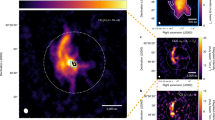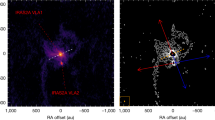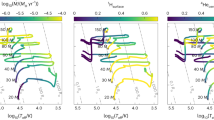Abstract
A critical step toward the emergence of planets in a protoplanetary disk is the accretion of planetesimals, bodies 1–1,000 km in size, from smaller disk constituents. This process is poorly understood, partly because we lack good observational constraints on the complex physical processes that contribute to planetesimal formation1. In the outer Solar System, the best place to look for clues is the Kuiper belt, where icy planetesimals survive to this day. Here we report evidence that Kuiper belt planetesimals formed by the streaming instability, a process in which aerodynamically concentrated clumps of pebbles gravitationally collapse into 100-kilometre-class bodies2. Gravitational collapse has previously been suggested to explain the ubiquity of equal-sized binaries in the Kuiper belt3,4,5. We analyse new hydrodynamical simulations of the streaming instability to determine the model expectations for the spatial orientation of binary orbits. The predicted broad inclination distribution with approximately 80% of prograde binary orbits matches the observations of trans-Neptunian binaries6. The formation models that imply predominantly retrograde binary orbits (for example, ref. 7) can be ruled out. Given its applicability over a wide range of protoplanetary disk conditions8, it is expected that the streaming instability also seeded planetesimal formation elsewhere in the Solar System, and beyond.
This is a preview of subscription content, access via your institution
Access options
Access Nature and 54 other Nature Portfolio journals
Get Nature+, our best-value online-access subscription
$29.99 / 30 days
cancel any time
Subscribe to this journal
Receive 12 digital issues and online access to articles
$119.00 per year
only $9.92 per issue
Buy this article
- Purchase on Springer Link
- Instant access to full article PDF
Prices may be subject to local taxes which are calculated during checkout



Similar content being viewed by others
Data availability
The data that support the plots within this Letter and other findings of this study are available from the corresponding author on reasonable request.
Code availability
The Athena code is available on GitHub (https://github.com/PrincetonUniversity/Athena-Cversion). The PLAN code is available on Zenodo44.
References
Youdin, A. N. & Kenyon, S. J. in Planets, Stars and Stellar Systems Vol. 3 (eds Oswalt, T. D., French, L. M. & Kalas, P.) 1–62 (Springer, 2013).
Youdin, A. N. & Goodman, J. Streaming instabilities in protoplanetary disks. Astrophys. J. 620, 459–469 (2005).
Nesvorný, D., Youdin, A. N. & Richardson, D. C. Formation of Kuiper Belt binaries by gravitational collapse. Astron. J. 140, 785–793 (2010).
Noll, K. S., Grundy, W. M., Chiang, E. I., Margot, J.-L. & Kern, S. D. in The Solar System Beyond Neptune (eds Barucci, M. A., Boehnhardt, H., Cruikshank, D. P. & Morbidelli, A.) 345–363 (University of Arizona Press, 2008).
Fraser, W. C. et al. All planetesimals born near the Kuiper belt formed as binaries. Nat. Astron. 1, 0088 (2017).
Grundy, W. M. et al. Mutual orbit orientations of transneptunian binaries. Icarus https://doi.org/10.1016/j.icarus.2019.03.035 (2019).
Goldreich, P., Lithwick, Y. & Sari, R. Formation of Kuiper-belt binaries by dynamical friction and three-body encounters. Nature 420, 643–646 (2002).
Yang, C.-C., Johansen, A. & Carrera, D. Concentrating small particles in protoplanetary disks through the streaming instability. Astron. Astrophys. 606, A80 (2017).
Johansen, A. et al. Rapid planetesimal formation in turbulent circumstellar disks. Nature 448, 1022–1025 (2007).
Johansen, A., Youdin, A. & Mac Low, M.-M. Particle clumping and planetesimal formation depend strongly on metallicity. Astrophys. J. Lett. 704, 75–79 (2009).
Bai, X.-N. & Stone, J. M. Dynamics of solids in the midplane of protoplanetary disks: implications for planetesimal formation. Astrophys. J. 722, 1437–1459 (2010).
Carrera, D., Gorti, U., Johansen, A. & Davies, M. B. Planetesimal formation by the streaming instability in a photoevaporating disk. Astrophys. J. 839, 16 (2017).
Kenyon, S. J. & Luu, J. X. Accretion in the Early Kuiper Belt. I. Coagulation and velocity evolution. Astron. J. 115, 2136–2160 (1998).
Morbidelli, A., Bottke, W. F., Nesvorný, D. & Levison, H. F. Asteroids were born big. Icarus 204, 558–573 (2009).
Weidenschilling, S. J. Initial sizes of planetesimals and accretion of the asteroids. Icarus 214, 671–684 (2011).
Simon, J. B., Armitage, P. J., Youdin, A. N. & Li, R. Evidence for universality in the initial planetesimal mass function. Astrophys. J. Lett. 847, 12–17 (2017).
Li, R., Youdin, A. N. & Simon, J. B. On the numerical robustness of the streaming instability: particle concentration and gas dynamics in protoplanetary disks. Astrophys. J. 862, 14–29 (2018).
Stone, J. M., Gardiner, T. A., Teuben, P., Hawley, J. F. & Simon, J. B. Athena: a new code for astrophysical MHD. Astrophys. J. Suppl. Ser. 178, 137–177 (2008).
Hayashi, C. Structure of the solar nebula, growth and decay of magnetic fields and effects of magnetic and turbulent viscosities on the nebula. Prog. Theor. Phys. Suppl. 70, 35–53 (1981).
Poincaré, H. Mémoires et observations. Sur l’équilibre d’une masse fluide animée d’un mouvement de rotation. Bull. Astron. 2, 109–118 (1885).
Benecchi, S. D., Noll, K. S., Stephens, D. C., Grundy, W. M. & Rawlins, J. Optical and infrared colors of transneptunian objects observed with HST. Icarus 213, 693–709 (2011).
Johansen, A. & Lacerda, P. Prograde rotation of protoplanets by accretion of pebbles in a gaseous environment. Mon. Not. R. Astron. Soc. 404, 475–485 (2010).
Gladman, B., Marsden, B. G. & Vanlaerhoven, C. in The Solar System Beyond Neptune (eds. Barucci, M. A., Boehnhardt, H., Cruikshank, D. P. & Morbidelli, A.) 43–57 (University of Arizona Press, 2008).
Parker, A. H. & Kavelaars, J. J. Destruction of binary minor planets during Neptune scattering. Astrophys. J. Lett. 722, 204–208 (2010).
Schlichting, H. E. & Sari, R. The ratio of retrograde to prograde orbits: a test for Kuiper Belt binary formation theories. Astrophys. J. 686, 741–747 (2008).
Johansen, A., Mac Low, M.-M., Lacerda, P. & Bizzarro, M. Growth of asteroids, planetary embryos, and Kuiper belt objects by chondrule accretion. Sci. Adv. 1, 1500109 (2015).
Bottke, W. F. et al. The fossilized size distribution of the main asteroid belt. Icarus 175, 111–140 (2005).
Petit, J.-M. et al. The absolute magnitude distribution of cold classical Kuiper belt objects. In American Astronomical Society DPS Meeting 48 120.16 (AAS, 2016).
Stern, A. et al. Initial results from the New Horizons exploration of 2014 MU69, a small Kuiper belt object. Science 364, eaaw9771 (2019).
Shannon, A. & Dawson, R. Limits on the number of primordial scattered disc objects at Pluto mass and higher from the absence of their dynamical signatures on the present-day trans-Neptunian populations. Mon. Not. R. Astron. Soc. 480, 1870–1882 (2018).
Colella, P. Multidimensional upwind methods for hyperbolic conservation laws. J. Comput. Phys. 87, 171–200 (1990).
Colella, P. & Woodward, P. R. The piecewise parabolic method (PPM) for gas-dynamical simulations. J. Comput. Phys. 54, 174–201 (1984).
Toro, E. F. Riemann Solvers and Numerical Models for Fluid Dynamics (Springer, 1999).
Bai, X.-N. & Stone, J. M. Particle-gas dynamics with Athena: method and convergence. Astrophys. J. Suppl. Ser. 190, 297–310 (2010).
Hockney, R. W. & Eastwood, J. W. Computer Simulation Using Particles (McGraw-Hill, 1981).
Youdin, A. & Johansen, A. Protoplanetary disk turbulence driven by the streaming instability: linear evolution and numerical methods. Astrophys. J. 662, 613–626 (2007).
Hawley, J. F., Gammie, C. F. & Balbus, S. A. Local three-dimensional magnetohydrodynamic simulations of accretion disks. Astrophys. J. 440, 742–763 (1995).
Simon, J. B., Armitage, P. J., Li, R. & Youdin, A. N. The mass and size distribution of planetesimals formed by the streaming instability. I. The role of self-gravity. Astrophys. J. 822, 55–72 (2016).
Masset, F. FARGO: a fast eulerian transport algorithm for differentially rotating disks. Astron. Astrophys. Suppl. Ser. 141, 165–173 (2000).
Stone, J. M. & Gardiner, T. A. Implementation of the shearing box approximation in Athena. Astrophys. J. Suppl. Ser. 189, 142–155 (2010).
Koyama, H. & Ostriker, E. C. Pressure relations and vertical equilibrium in the turbulent, multiphase interstellar medium. Astrophys. J. 693, 1346–1359 (2009).
Abod, C. P. et al. The mass and size distribution of planetesimals formed by the streaming instability. II. The effect of the radial gas pressure gradient. Preprint at https://arxiv.org/abs/1810.10018 (2018).
Chiang, E. & Youdin, A. N. Forming planetesimals in solar and extrasolar nebulae. Annu. Rev. Earth Planet. Sci. 38, 493–522 (2010).
Li, R. PLAN: PLanetesimal ANalyzer version 0.2, https://doi.org/10.5281/zenodo.143680710.5281/zenodo.1436807 (2018).
Eisenstein, D. J. & Hut, P. HOP: a new group-finding algorithm for N-body simulations. Astrophys. J. 498, 137–142 (1998).
Morton, G. M. A Computer Oriented Geodetic Data Base and a New Technique in File Sequencing (International Business Machines, 1966).
Barnes, J. & Hut, P. A hierarchical O(N log N) force-calculation algorithm. Nature 324, 446–449 (1986).
Lissauer, J. J. & Kary, D. M. The origin of the systematic component of planetary rotation. I—Planet on a circular orbit. Icarus 94, 126–159 (1991).
Dones, L. & Tremaine, S. On the origin of planetary spins. Icarus 103, 67–92 (1993).
Acknowledgements
The work of D.N. was funded by the NASA Emerging Worlds programme. R.L. acknowledges support from NASA grant NNX16AP53H. A.N.Y. acknowledges support from NASA through grant NNX17AK59G and the NSF through grant 1616929. The funding sources of J.B.S. are NASA grants NNX13AI58G, NNX16AB42G, 80NSSC18K0640 and 80NSSC18K0597. W.M.G.’s contribution was supported in part by NASA Keck PI Data Awards, administered by the NASA Exoplanet Science Institute, and in part by data analysis grants from the Space Telescope Science Institute (STScI), operated by the Association of Universities for Research in Astronomy, Inc. (AURA), under NASA contract NAS 5-26555.
Author information
Authors and Affiliations
Contributions
D.N. suggested a comparison of clump obliquities with binary orbit inclinations and prepared the manuscript for publication. R.L. ran one of the Athena simulations and performed data analyses with PLAN. A.N.Y. developed scaling relations for planetesimal mass estimates. J.B.S. ran two of the Athena simulations. W.M.G. provided the data on trans-Neptunian binaries. All authors contributed to the interpretation of the results and writing of this letter.
Corresponding author
Ethics declarations
Competing interests
The authors declare no competing interests.
Additional information
Peer review information: Nature Astronomy thanks J. J. Kavelaars and the other, anonymous, reviewer(s) for their contribution to the peer review of this work.
Publisher’s note: Springer Nature remains neutral with regard to jurisdictional claims in published maps and institutional affiliations.
Supplementary information
Supplementary information
Supplementary text, Supplementary Video caption, Supplementary references, Supplementary Table 1 and Supplementary Figs. 1–5.
Supplementary Video
Supplementary Video
Rights and permissions
About this article
Cite this article
Nesvorný, D., Li, R., Youdin, A.N. et al. Trans-Neptunian binaries as evidence for planetesimal formation by the streaming instability. Nat Astron 3, 808–812 (2019). https://doi.org/10.1038/s41550-019-0806-z
Received:
Accepted:
Published:
Issue Date:
DOI: https://doi.org/10.1038/s41550-019-0806-z
This article is cited by
-
Trojan Asteroid Satellites, Rings, and Activity
Space Science Reviews (2023)
-
Origin and Evolution of Jupiter’s Trojan Asteroids
Space Science Reviews (2023)
-
The accretion of planet Earth
Nature Reviews Earth & Environment (2022)
-
Giant planet imaged orbiting two massive stars
Nature (2021)
-
Shapes, structures, and evolution of small bodies
Astrodynamics (2021)



